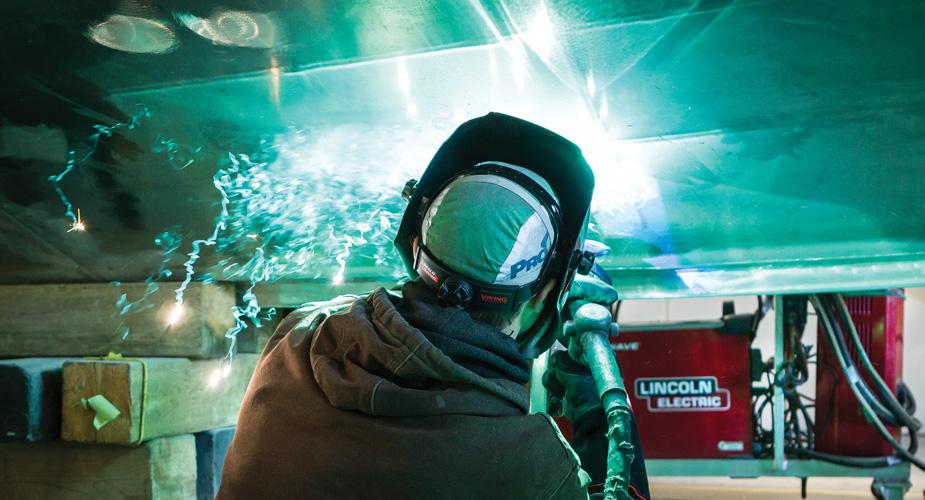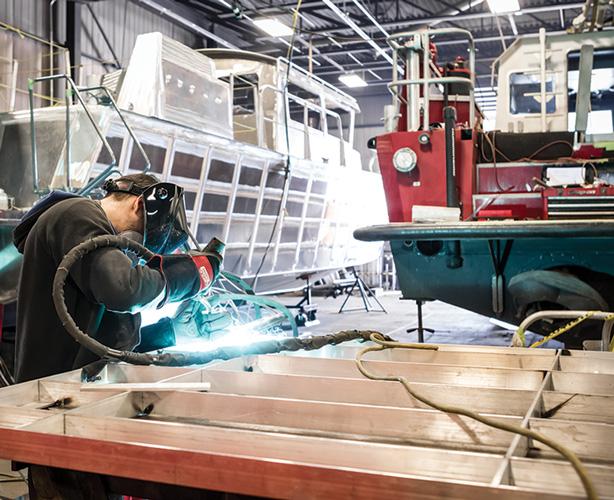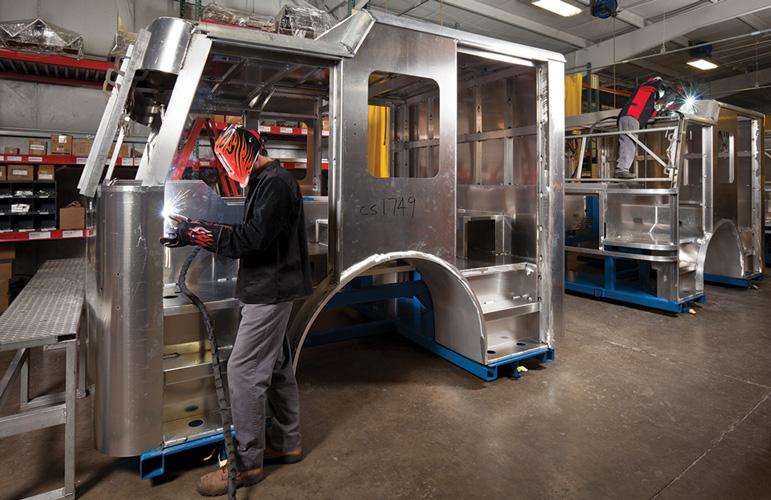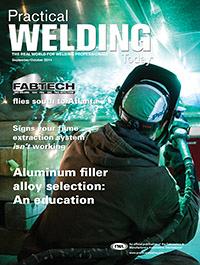Director, Global Sales and Technical Service
- FMA
- The Fabricator
- FABTECH
- Canadian Metalworking
Categories
- Additive Manufacturing
- Aluminum Welding
- Arc Welding
- Assembly and Joining
- Automation and Robotics
- Bending and Forming
- Consumables
- Cutting and Weld Prep
- Electric Vehicles
- En Español
- Finishing
- Hydroforming
- Laser Cutting
- Laser Welding
- Machining
- Manufacturing Software
- Materials Handling
- Metals/Materials
- Oxyfuel Cutting
- Plasma Cutting
- Power Tools
- Punching and Other Holemaking
- Roll Forming
- Safety
- Sawing
- Shearing
- Shop Management
- Testing and Measuring
- Tube and Pipe Fabrication
- Tube and Pipe Production
- Waterjet Cutting
Industry Directory
Webcasts
Podcasts
FAB 40
Advertise
Subscribe
Account Login
Search
Choosing the right aluminum filler alloy
Factors to consider to achieve quality aluminum welds
- By Gregory Doria
- Updated May 18, 2023
- September 22, 2014
- Article
- Consumables

It is not a good idea to use 1XXX filler alloys for welding non-1XXX series base material, nor should they be used to weld 1XXX base material to a base material in a different series. In these situations, the weld will draw in alloying additions from the base alloy being welded, resulting in crack-sensitive weld chemistry. (Photos courtesy of Lincoln Electric, Cleveland.)
Many fabricators faced with an aluminum project often wonder what the best filler metal is for the job. The answer depends on the specific application and the filler characteristics that are most important for that application. By considering the following application factors, fabricators can determine which filler alloy to use.
Factor No. 1: Aluminum Filler Cracking Susceptibility
Aluminum cracking, commonly referred to as hot cracking, occurs as the aluminum weld solidifies. The solidifying weld’s chemistry is the single most important factor in determining cracking sensitivity. This chemistry is determined by the base metal, the filler metal, and the weld dilution. Therefore, the specified filler alloy plays a crucial role in determining cracking sensitivity.
Factor No. 2: Final Weld Strength
Both the substrate and the type of weld can affect choice of filler material and ultimately weld strength. When using aluminum, fabricators rarely obtain a weld that is as strong as the base metal. In groove welds, the tensile strength of the weld is critical as the weld is usually stressed in tension. In contrast, in lap or fillet welds, the shear strength of the weld is critical since the weld is usually stressed in shear. Different filler metals have differing tensile and shear strengths.
Factor No. 3: Weld Appearance and Aesthetics
Different alloys can provide a variety of finished-weld appearances. Some filler alloys have a greater tendency to produce a black, sooty residue on the weld surface, while others tend to be more fluid and easier to wet-in.
The 4XXX series, known as AlSi filler metals, have excellent fluidity, which gives an exceptional weld appearance and very good resistance to weld cracking. In addition, these filler metals are less prone than the 5XXX series alloys to develop porosity in the weld.
In determining the proper filler metal in respect to weld appearance, welders should also consider whether the final part will be anodized
after welding. Anodizing is an electrochemical process that produces a relatively thick coating of aluminum oxide on the surface of aluminum. This coating is very hard but porous enough to absorb organic dyes. While the final anodized coating results in a clear satin color, some alloys may impart a slight color cast to the anodizing. If desired, an organic dye can be infused into the coating later, providing a decorative wear surface on aluminum components. 5XXX series filler alloys should be used in this case to provide the best color match. If a 4XXX series filler is used, the weld will become an unattractive black color after anodizing.
Factor No. 4: Maritime Service or Corrosive Environments
In most cases, the base material the welder uses plays the biggest role in resisting corrosion. The filler metal is chosen primarily to be a match.
Factor No. 5: Aluminum Filler Elevated-temperature Service
It is a well-known phenomenon that 5XXX alloys containing more than 3 percent magnesium (Mg) can be sensitized to stress-corrosion cracking with exposure to temperatures of more than 150 degrees F for extended periods of time—as in an automotive engine cradle, for example. Other base metal alloys with less than 3 percent Mg, such as 5454, were developed for such service. Matching filler alloys, such as 5554, are available to weld these alloys.
Factor No. 6: Deformation Under Stress
Ductility is not an important filler metal characteristic for most welding applications. However, it becomes important if the weldment is to be deformed after welding by rolling or bending.

Choosing the right aluminum filler alloy has a lot to do with understanding your application and the necessary results. Those and other considerations will lead you to the correct alloy.
Aluminum Filler Metal Alloys Available and Proper Use Guidelines
Aluminum filler alloys come from the 1XXX, 2XXX, 4XXX, and 5XXX alloy families. Within these families, a number of alloys are available that best meet the needs of specific applications.
1XXX: Essentially Pure Aluminum Filler Alloys. In general, 1XXX alloys are very pure, which makes them good candidates for applications in which the primary characteristic of the weldment is excellent electrical conductivity. None of these alloys are sensitive to cracking. That being said, it is best to match the filler alloy to the parent material being welded. For example, an operator would use 1100 filler to weld 1100 parent material.
Sometimes it might be difficult or impossible to find an exact match. In such a situation, a welder should use a filler alloy that is at least as pure as the parent material. Purity is specified in the last two digits of the alloy designation for 1XXX series. For example, 1100 is 99.0 percent pure and 1070 is 99.7 percent pure.
It is not a good idea to use 1XXX filler alloys for welding non-1XXX series base material, nor should they be used to weld 1XXX base material to a base material in a different series. In these situations, the weld will draw in alloying additions from the base alloy being welded, resulting in crack-sensitive weld chemistry.
The 1XXX filler wires are very soft and can be problematic to feed. As a result, a push/pull torch is recommended with these filler alloys.
2XXX: Aluminum Copper Filler Alloys. The only 2XXX filler alloy readily available is 2319. This alloy contains copper (Cu), manganese (Mn), and titanium (Ti), and it was designed as a matching filler metal for the 2219 alloy. It is also used quite successfully for welding aluminum armor alloy 2519. This heat-treatable alloy responds to postweld heat treatment, resulting in increased strength. Other than that, it really has no other application.
4XXX: Aluminum Silicon Filler Alloys. Featuring silicon (Si) as the primary alloying element, the most common 4XXX fillers, 4043 and 4047, are simple binary AlSi alloys. Some of the 4XXX fillers, such as 4643 and 4010, have a small amount of Mg, which helps to make the weld heat-treatable to more closely match the base metal properties. This is especially important in applications where the welded assembly will be completely reheat-treated—solution heat-treated, quenched, and aged—after welding.
Some 4XXX filler alloys also are made to match various casting alloys, such as R-A356.0 and R-A357.0. These fillers are used in foundries to repair 3XX castings before they are heat-treated so that the chemistry of the weld matches that of the casting.
The AlSi filler metals are characterized by excellent fluidity and very good resistance to weld cracking. In addition, they are less prone to develop porosity in the weld than the 5XXX fillers.
The 4XXX fillers are widely used to weld 6XXX extrusions and sheet or plate. They are also used to weld castings to 6XXX alloys and to themselves. In fact, during welding of 6XXX alloys, which are prone to cracking, the AlSi chemistry of the 4XXX filler, when diluted with the 6XXX base alloy, provides a weld chemistry that is highly crack-resistant.

In respect to weld appearance, you also should consider whether the part will be anodized after welding. 5XXX series alloys are much better-suited for anodizing than, for example, 4XXX series, because they provide the best color match. 4XXX series alloys become an unattractive black color after anodizing.
It is not recommended that welders use 4XXX fillers to weld AlMg 5XXX alloys, such as 5083. The high Si content of the 4XXX alloys, when combined with the high Mg of the 5XXX base material, produces the intermetallic compound magnesium silicide, which is an exceptionally brittle substance. Consequently, the weld tends to have poor ductility and toughness. The one exception is welding 5052 using 4043. This works because 5052 has a low Mg content. Base material 5052 also can be welded using 5XXX fillers.
While 4XXX fillers are stronger than 1XXX fillers, they are soft enough that feeding difficulties sometimes occur in gas metal arc welding (GMAW). For this reason, push/pull guns and feeders are recommended but not always necessary with larger diameters.
5XXX: Aluminum Magnesium Filler Alloys. The 5XXX fillers, of which 5356 is the most common, often are simple AlMg binary alloys. With these, the higher the Mg content, the stronger the welds. Some higher-strength 5XXX fillers, such as 5556 and 5183, also have manganese added to further increase the strength.
The weld appearance is not as smooth because 5XXX fillers are not as fluid and because of the presence of Mg, which sometimes leaves behind a black weld residue, especially during GMAW.
However, the mechanical properties of the 5XXX fillers are much better than those of the 4XXX fillers. The ductility of 4043 filler is between 6 and 10 percent, while that of 5356 is about 25 percent. The shear strength of 5356 is approximately 50 percent higher than that of 4043.
While the tensile strength of 5356 is also greater than that of 4043, this advantage is usually negated by the fact that in most cases the heat-affected zone (HAZ) of a groove weld is the weak point, not the weld itself.
The 5XXX alloys are used for three main types of applications. First, they are used to join 5XXX base materials to each other. In this application, the general rule is to use a filler alloy with slightly more Mg than the base alloy.
- 5554 or 5754 is used to weld alloys with low Mg content like 5052, 5154, and 5454.
- 5356 is used to weld intermediate-strength alloys such as 5086 and 5083. Sometimes 5183 is selected for increased mechanical properties.
- 5183, 5556, and 5087 are used to weld the highest-strength 5XXX alloys.
Second, in an equally important application, the 5XXX fillers, specifically 5356, often are used to weld the 6XXX base alloys such as 6061 and 6063 when mechanical property considerations are paramount.
Finally, 5XXX fillers, again primarily 5356, should be used to weld 5XXX and 6XXX alloys when the weldment will be anodized after welding. As mentioned previously, if a 4XXX filler is used in this application, the welds will anodize to an unattractive black color.
5XXX fillers should not be used to weld 3XX casting alloys, such as A356 and A319, because these materials contain a lot of Si and excessive magnesium silicide will be formed.
When it comes to selecting the proper filler alloy, operators must understand their application and its objectives and also know their base material and its properties. This knowledge will affect which filler metal to use. Careful consideration of all factors involved will pave the way for making the right filler metal choice with confidence and with a successful end result.
About the Author
Gregory Doria
22801 St. Clair Ave.
Cleveland, OH 44117
416-346-6652
About the Publication
Related Companies
subscribe now

The Welder, formerly known as Practical Welding Today, is a showcase of the real people who make the products we use and work with every day. This magazine has served the welding community in North America well for more than 20 years.
start your free subscription- Stay connected from anywhere

Easily access valuable industry resources now with full access to the digital edition of The Fabricator.

Easily access valuable industry resources now with full access to the digital edition of The Welder.

Easily access valuable industry resources now with full access to the digital edition of The Tube and Pipe Journal.
- Podcasting
- Podcast:
- The Fabricator Podcast
- Published:
- 04/16/2024
- Running Time:
- 63:29
In this episode of The Fabricator Podcast, Caleb Chamberlain, co-founder and CEO of OSH Cut, discusses his company’s...
- Trending Articles
Sheffield Forgemasters makes global leap in welding technology

Welding student from Utah to represent the U.S. at WorldSkills 2024

Lincoln Electric announces executive appointments

Lincoln Electric acquires RedViking

Engine-driven welding machines include integrated air compressors

- Industry Events
16th Annual Safety Conference
- April 30 - May 1, 2024
- Elgin,
Pipe and Tube Conference
- May 21 - 22, 2024
- Omaha, NE
World-Class Roll Forming Workshop
- June 5 - 6, 2024
- Louisville, KY
Advanced Laser Application Workshop
- June 25 - 27, 2024
- Novi, MI


























